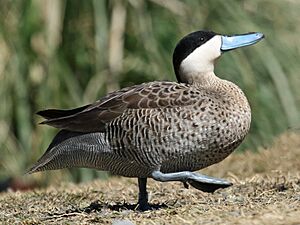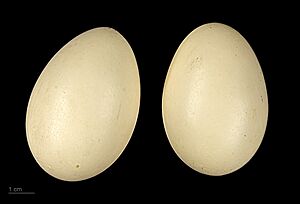Puna teal facts for kids
Quick facts for kids Puna teal |
|
|---|---|
 |
|
| A puna teal at Sylvan Heights Waterfowl Park in Scotland Neck, North Carolina. | |
| Conservation status | |
| Scientific classification | |
| Genus: |
Spatula
|
| Species: |
puna
|
 |
|
| Synonyms | |
|
Anas versicolor puna |
|
The Puna teal (Spatula puna) is a type of dabbling duck that belongs to the Anatidae family. It was once thought to be a smaller group (subspecies) of the silver teal.
You can find the Puna teal living in the Andes mountains. They live in countries like Peru, western Bolivia, northern Chile, and the very northwest part of Argentina. These ducks like to live on big lakes and ponds in the high mountain plains called the altiplano.
The Puna teal is listed as "Least Concern" on the IUCN Red List. This means there are still plenty of them around, and they are not in danger of disappearing.
What It Looks Like

The Puna teal is about 19 inches (48 cm) long, which is similar in size to a wood duck. They have a black cap on their head that goes down past their eyes. Their lower face and neck are a creamy white color.
The feathers on their upper tail are gray. Their back and chest are a light coffee color with dark brown spots. The sides of their body are dark brown with thin stripes. They have a large, light blue bill with a black line running down the middle.
How Puna Teals Live
In the wild, Puna teals often live in small groups. Sometimes they are with other Puna teals, and sometimes they mix with the similar silver teal.
Puna teals lay their eggs between April and June. Just like swans and geese, both the mother and father Puna teal help to raise their ducklings. They lay their eggs in tall grass, and it's not always right next to the water. The eggs are a creamy pink color, and a female can lay several at once. The male and female Puna teal often stay together for a long time.



